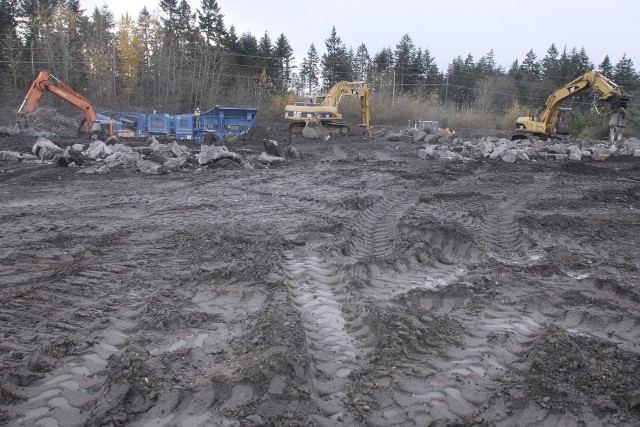FORT LEWIS, Wash. - When it comes to recycling on Fort Lewis, Ken Smith has a concrete solution - literally.
Smith, the Resource Conservation and Recovery Act program manager with the Environmental Division of Fort Lewis Public Works, is overseeing the installation's efforts to pull concrete rubble from demolished buildings out of a 6-acre landfill site and use it to create a storm-water infiltration and retention system for new construction on North Fort.
"We're removing that (landfill) cell," Smith said. "It basically starts at ground level and goes up probably ... 12 feet deep for that whole area."
Tens of thousands of cubic yards of concrete, asphalt, scrap metal and soil are being mined from the landfill. Millions of dollars ultimately will be saved by recycling the materials.
"One hundred percent of the concrete and 100 percent of the soil that's recovered from this area will be used in here," Smith said. "The only thing they're pulling to the side is the asphalt. It will be moved ... into our asphalt-recovery area. We grind it and reuse it on the roads. A hundred percent of everything coming out of here will be used."
The consolidation of storm-water treatment facilities will provide much-needed space on North Fort.
"We're freeing up acreage so they can do more construction," Smith said.
"All the individual storm-water systems that they have on North Fort ... each one of those takes up real estate," said Ron Norton, solid waste and recycling program manager with the Environmental Division. "So by consolidating about half of the stormwater from North Fort through this system ... we were able to save real estate."
The consolidated system will keep untreated storm water out of Puget Sound.
"We will literally treat all of it here and infiltrate into the ground, and we will eliminate a discharge of stormwater from North Fort," Smith said.
The landfill itself will be returned to a more natural state once all the materials are extracted from it, Smith said.
"In our recovery and management plan for the landfill once we closed it, part of that was to change it to a habitat that would support a whole bunch of wildlife," Smith said. "Part of it was developing a wetland out here. Well, this is even better, because now we have a water source that will actually add more than just seasonal rainwater to this site. And it will actually improve the habitat for some of the endangered species."
"It's going to be a complete cleanup," Norton said. "We're taking wastes and making usable products."
According to the Construction Materials Recycling Association, 140 million tons of concrete are recycled in the U.S. alone each year. On its Web site, the CMRA points out that used concrete is of high quality, performs better and is lighter than new aggregate, and is environmentally friendly.
The concrete-recycling project at Fort Lewis is part of the installation's sustainability program, which has a goal of zero net waste by 2025.
"Under the zero-net-waste concept, we no longer send anything out the gate," Smith said. "We recover everything. We use it in future projects."
That recovery extends beyond concrete, asphalt and scrap metals to such materials as food waste.
"We started with a baseline of 22,000 tons of refuse going off this installation in 2002, and we cut that in half," Smith said. "Last year, we sent only 12,000 tons off. So we're making big progress."
According to Smith, all the materials being recovered from Fort Lewis landfills are destined for use elsewhere on post.
"Everything we develop ... is spoken for this entire year," Smith said. "I can't make it fast enough, and these project managers at the Corps (of Engineers) and within (Public Works) are clamoring for the materials."
Bob Reinert is a reporter with Fort Lewis' Northwest Guardian.


Social Sharing